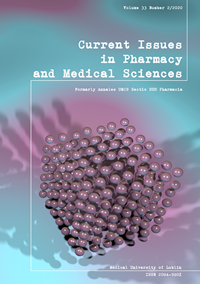Comparative characteristics of proton pump inhibitor effectiveness in the treatment of gastric ulcer and duodenal ulcer
DOI:
https://doi.org/10.2478/cipms-2020-0011Keywords:
antidepressant, peptic ulcer, proton pump inhibitors, efficiencyAbstract
Aim. The aim of this study is to evaluate the efficiency of proton pump inhibitors in the treatment of gastric and duodenal ulcers as based on literature.
Materials and methods. The materials of this research are the results of 86 original studies on the effectiveness of proton pump inhibitors analysis.
Methods. Descriptive, statistical, retrospective.
Results and Conclusion. According to the clinical random researches, Omeprazole preparations are not included in the list due to proven better effectiveness of Esomeprazole drugs. Moreover, lansoprazole drugs are not included according to proven short-acid inhibitory effect. In addition, the brand of mentioned above preparation does not exist on the pharmaceutical market of Ukraine. Furthermore, rabeprazole preparations are presented in the research by Pariet (brand) and by the effective generic Barol, while pantoprazole preparations are represented in the research by Kontrolok (brand) and by the generic Pultset, as well as by Nolpaza. Herein, the Pantosan effect was not significantly different from the effect of Pultset and Nolpaza, but the preparation is much more expensive. In terms of efficiency (%), 4 week repair of mucosal defects was carried out by way of the following treatment regimens: Barol + Amoxicillin + Clarythromycin (90.9±6.2), Pariet + Amoxicillin + Clarythromycin (83±2.6), Kontrolok + Amoxicillin + Clarythromycin (100±1.3), Pultset + Amoxicillin + Clarythromycin (88±4.1), Nolpaza + Amoxicillin + Clarythromycin (72±4.1), Ezolonh + Amoxicillin + Clarythromycin (87.7±3.8), Neksium + Amoxicillin + Clarythromycin (96.1±3.1).
References
1. Zaychenko AV, Bryukhanova TA. Innovative approaches to pharmacological correction of hypersecretory conditions. Pharm Weekly. 2012;43:864-7
2. Stepanov YM. Digestive diseases and gastroenterological help to the population of Ukraine: achievements, problems and ways of their solution. Health of Ukraine. 2014;3(33):10-1.
3. Morozov AM, Yakovleva LV, Bezditko NV, Mishchenko OY, Stepanenko AV, Zimenkovsky A B. Evaluation of the clinical and economic feasibility of the use of drugs in a healthcare institution (suport of the formular system): method. rivers. Kh. Style Publishing; 2013:36-8.
4. Yakovleva LV Gerasimova OO, Gorbacheva AS, Yakovleva LV. Clinical and economic aspects of pharmacotherapy of patients with peptic ulcer. Pharm J.2015; 3:83-7.
5. Germanyuk TA, Bobryuk VP, Balanchuk TI, Tikholaz SI. Modern Classifications of Essential Medicines: Educational Posinik. Vinnytsya: National Pirogov Memorial Medical University; 2018:126-8.
6. Sikal MO, Sikal MO. Application of X-ray and vascular hemostasis in the complex of surgical treatment of acute gastrointestinal bleeding of ulcerativegenesis. Kharkiv Surgical School. 2013;4(61):96-8.
7. Fomin PD, Nikishaev VI. Bleeding from the upper gastrointestinal tract: causes, risk factors, diagnosis, treatment. Health of Ukraine. 2010;2:8-11.
8. Lazebnik LB, Guseinzade LB, Efremov LI. Estimation of the total cost of inpatient treatment of duodenal ulcer associated with H. pylori. Qual Clin Practice. 2008;2:62-70.
9. Gerasimova OO, ZagrebelnaYM. Pharmacoeconomic analysis of different regimens of anti-helicobacter therapy of peptic ulcer and duodenum. Ration Pharmacother. 2010;4:32-6.
10. Oisodlo GV, Prokopchuk SM, Voitsekhovsky OM. Components of the effectiveness of anti-helicobacter therapy in H. Pylory-associated diseases of the digestive system. Health of Ukraine. 2014;2:31-2.
11. Solovyov OS, Gudzenko IO, Levchenko OP. Kozitska KI. Pharmacoeconomic evaluation of the use of proton pump inhibitors in the treatment of stomach ulcer. Ukrainian Medical Almanac. 2013;16(4):54-6.
12. Germanyuk TA, Dzyubenko SP. Research of the pharmaceutical market of anti-herbicacid preparations and analysis of minimization of expenses of anti-herbic bacterial therapy. Curr Issues Pharm Med Sci Prac. 2012;2:102-6.
13. Grushhkovskaya DT. Pharmacoeconomic aspects of medical provision of patients with peptic ulcer in the stomach and duodenum. Pharmaceut Mag. 2014;4:125-8.
14. Orlovsky VF, Orlovsky AV, Murenets NA. Clinical efficiency of rabeprazol in patients with peptic duodenal ulcer. Health Medic. 2008;3(119):67-9.
15. Scherbinina MB. Nolpaza – a promising proton pump inhibitor. Mod Gastroenterol. 2010;56(6):83-7.
16. Ilchenko AA. Computer pH-metry of the stomach and esophagus. The clinical significance of the method: Methodical recommendations. Moscow: Moscow City Health Department; 2001:40.
17. Ivashkin VT, Sheptulin AA, Makarov YS, Nemytin YV. Comparative evaluation of the antisecretory activity of the LAPM MAPS, pariet and nexium in patients with peptic ulcer. Clin Persp Gastroenterol Hepatol. 2002;5:19-22.
18. Wang H, Nie YQ, Dai SJ. The effect of proton pump inhibitor on intragastric acidity and it relation to S-mephenytoin hydroxylase genetic polymorphism. Zhonghua Nei Ke Za Zhi. 2003;42:777-80.
19. Babak OY. Comparative evaluation of the clinical efficacy of Rabeprazole and other proton pump inhibitors according to the results of a meta-analysis. Mod Gastroenterol. 2007;3(35):53-7.
20. Dashiyev TD, Plehanov AN, Tovarshinov AI. Comparative evaluation of the effect of various inhibitors of proton pump (omeprazole, nexium, control) in the treatment of patients with ulcers of the stomach and duodenum. [Electronic resource] http://www.rusnauka.com/34_NIEK_2013/Medecine/6_148522.doc.htm
21. Peredery VG, Chernyavsky VV, Dudar LV. Experience with the use of the drug „Pultset” for the treatment of patients with gastroesophageal reflux disease. Mod Gastroenterol. 2010;2(52):70-3.
22. Vasilyev YuV, Kasyanenko VI. Efficienty of 1-week application of Ezomeprazol (Nexium), Claritromycine and Amoxicillin in the treatment of extractive disease associated with helicobacter pylory. Medicina svitu. 2004;3. [Electronic resource] http://msvitu.com/archive/2004/march/article-10.php.
Downloads
Published
Issue
Section
License
Copyright (c) 2020 Authors

This work is licensed under a Creative Commons Attribution-NonCommercial-NoDerivatives 3.0 Unported License.


